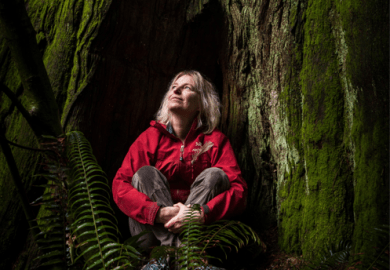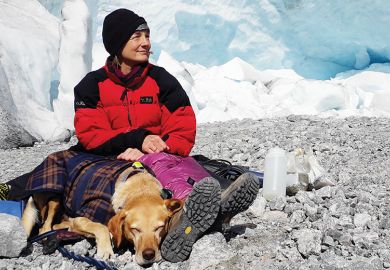Keith Thomson meets the main players who Enlightened Earth history
In this huge work, Martin Rudwick, the distinguished historian of geology and palaeontology, has tackled a massive subject: an account of attempts to discover "the immensely long and complex history" of the Earth.
This is a truly comprehensive survey of work during the late Enlightenment in geognosy (empirical investigation into the nature of the Earth), geotheory and geochronology, leading to the beginnings of a modern view of geohistory. Rudwick concentrates on "soft-rock" geology and fossils (rarely the fossil plants), to the exclusion of hard-rock processes and largely ignores natural philosophy (a term that does not appear in the index).
Rudwick's subtitle refers to the fact that his chosen time frame is the period between the French Revolution (1789-99) and the European revolutions of 1848, although in this book he stops around 1820.
It soon becomes apparent also that his focus is almost entirely on the continental side of the Channel.
Science, always an international adventure, was then dominated by France, Germany and Austria. That being the case, Rudwick distinguishes his work from those studies in the history of science that are set in single national cultures or written by authors who have no command of a language other than English. His scorn for "the latter kind of fool" is not tempered; mastery of languages is not a problem from which Rudwick himself suffers. Quite apart from Rudwick's historicising, his exposition of the work of continental scholars, much of which will be unfamiliar to many Anglophone readers, alone would make the book invaluable. As a master of this field, Rudwick does not hesitate to confess (or, perhaps, gently boast) that his approach to the works of scholars of the period is "deeply unfashionable" in that it concentrates on the science itself rather than the cultural setting of its authors. However, he is deeply contemporary in resisting any urge to set past studies against the standard of modern knowledge. Rudwick takes this a step further; he neither frames his research in terms of any kind of progressivism nor refers back to what went before. This allows him deliberately to avoid some of the usual cliches.
The reader will search in vain, for example, for references to Leonardo da Vinci's thoughts on the perennial paradox that fossil seashells are usually found far inland from the sea, or high up on mountain sides, or both. This approach also fits with his avoidance of most contemporary attempts at geological theory.
Rudwick's thesis is that scholars came to their approaches to Earth history by extension of an understanding of human history. "Ideas, concepts and methods for analysing evidence and for reconstructing the past were deliberately and explicitly transposed from the human world into the world of nature." Scholars were therefore intellectually prepared for the breakthrough discovery that the world of nature was contingent, rather than being wholly bound by the laws of nature. Furthermore, they were prepared to try to understand the world of nature within the intellectual framework of the Christian religion and as part of a divine drama "of contingent events, suffused with divine meaning and intent". In other words (as, among others, John Hedley Brooke has argued in Science and Religion , and I have argued in Before Darwin ), religion and science were not yet opposed in this world of inquiry.
The same scholars were less prepared for the discovery that there was a history to the Earth, perhaps of immense duration, that preceded the arrival of humans.
The book is divided into two parts. The first is a "synchronic" review of the scholarly state of play around 1787: Rudwick marks this time with repeated (as even he admits, tiresomely repeated) references to the ascent of Mont Blanc by Horace-Benedict de Saussure on August 3 of that year. The only British author to get any kind of a decent mention is James Hutton, but here Rudwick's usually even-handed approach seems to have escaped him, perhaps in an attempt to go beyond the usual cliches (Rudwick likes the word "vulgar") and to avoid geotheory. Rudwick concentrates on casting Hutton, somewhat unconvincingly in my view, as someone who only saw the world as eternal, as did Aristotle, rather than having a history. This does not fit well with the first sentences of Hutton's 1785 A bstract of a Dissertation Concerning the System of the Earth, its Duration, and Stability : "The purpose of this Dissertation is to form some estimate with regard to the time the globe of this Earth has existed, as a world maintaining plants and animal; to reason with regard to the changes which the Earth has undergone; and to see how far an end or termination to this system of things may be perceived." Hutton's conclusion was only that Earth processes required an "indefinite space of time"; but what he was doing, of course, was developing a view of earth history that was more lawful than contingent.
In building a foundation for the rest of the work, this first half has its better known stars, such as Georges Buffon, Jean Andre de Luc (the elder), Francois-Xavier Burtin, Nicolas Desmarest and Abraham Gottlob Werner (here rescued from his own burden of cliches) and Hutton. It is Rudwick's object, however, to be comprehensive rather than to single out particular authors.
He emphasises a scholar's work for its importance in a contemporary context. In his approach, what people actually did is much more important than which philosophies they might have favoured or even where their work led. Where it came from is usually also left unsaid, which may be fair enough for Rudwick's didactic goals but does lead to jarring notes. For example, when reading of de Luc's theory of phases of the Earth, the last of which involved the collapse of "vast unseen caverns in the Earth's interior", one expects to be reminded that Steno (another geotheorist) had proposed this mechanism more than a century before. On the other hand, there are many gems to be found among the unfamiliar names, and it seems perfectly fitting that after Saussure's name has been trailed across the first 291 pages, it should turn out that he had contributed rather little to the ensuing decades.
The second half of the book is a more "diachronic" review, in almost narrative form, of people and work relating specifically to the development of an understanding of geohistory from 1787 to 1848. The hero of this part of the book, without doubt, is Georges Cuvier, whose life and work has already been documented by Rudwick ( Georges Cuvier, Fossil Bones and Geological Catastrophes ) but not nearly as interestingly as here. Rudwick wonderfully maps the changes in Cuvier's knowledge and thinking with respect to the evidence that fossils provided concerning what Hutton called the "successive worlds" that constituted the Earth. Slowly Cuvier gave up the idea that there had been only an older world and the present, separated by one giant catastrophe. Much of the change in his thinking came from his empirical discoveries in the Paris Basin with Adolphe Brongniart. In the process, William Smith is given his rightful place as the discoverer of principles of correlation of strata by their fossil signatures, leading to ways of documenting geognosy on a large scale in the form of detailed geological maps, unencumbered by theory.
The book ends with a series of chapters linking Cuvier with men as different as Leopold von Buch in Berlin and William Buckland in Oxford, all investigating evidence that might indicate some kind of quite recent flood.
And, if not the biblical flood, then some other kind of aquatic event on a massive, catastrophic scale. In addition to the deposits of gravels, sands and soils known for a century or more as diluvial, and unusual accumulations of fossil bones, there were the "erratics", isolated chunks of rock the size of a house and clearly identifiable as having originated dozens or hundreds of miles away. Rudwick cleverly brings readers to the point where, like the audience at the pantomime shouting out "behind you", we want to yell "glaciers". But there the book ends (fittingly perhaps) without having arrived at a conclusion.
The book is beautifully produced, although it is worth mentioning that the use of heavy gloss stock not only makes such a long book (more than 700 pages) extremely heavy (2.4kg) but hard on the eyes. The paper was presumably chosen for optimum reproduction of the many contemporary figures that Rudwick rightly insists are essential to understanding his subjects.
He opens the book with a note about his footnotes, which are numerous and add greatly to the ease of reading, and explains that at every stage even short sections of the text are given their own "conclusions" to aid the reader. "Begin at the beginning and when you get to the end, stop." Good advice, but firmly ignored by Rudwick in this brilliant, exhaustive (in places exhausting), treatise. No geologist, palaeontologist or historian of science can afford to be without it.
Keith Thomson is professor emeritus of natural history at Oxford University and senior research fellow of the American Philosophical Society.
Bursting the Limits of Time: The Reconstruction of Geohistory in the Age of Revolution
Author - Martin Rudwick
Publisher - Chicago University Press
Pages - 840
Price - £28.50
ISBN - 0 226 73111 1
Register to continue
Why register?
- Registration is free and only takes a moment
- Once registered, you can read 3 articles a month
- Sign up for our newsletter
Subscribe
Or subscribe for unlimited access to:
- Unlimited access to news, views, insights & reviews
- Digital editions
- Digital access to THE’s university and college rankings analysis
Already registered or a current subscriber?



